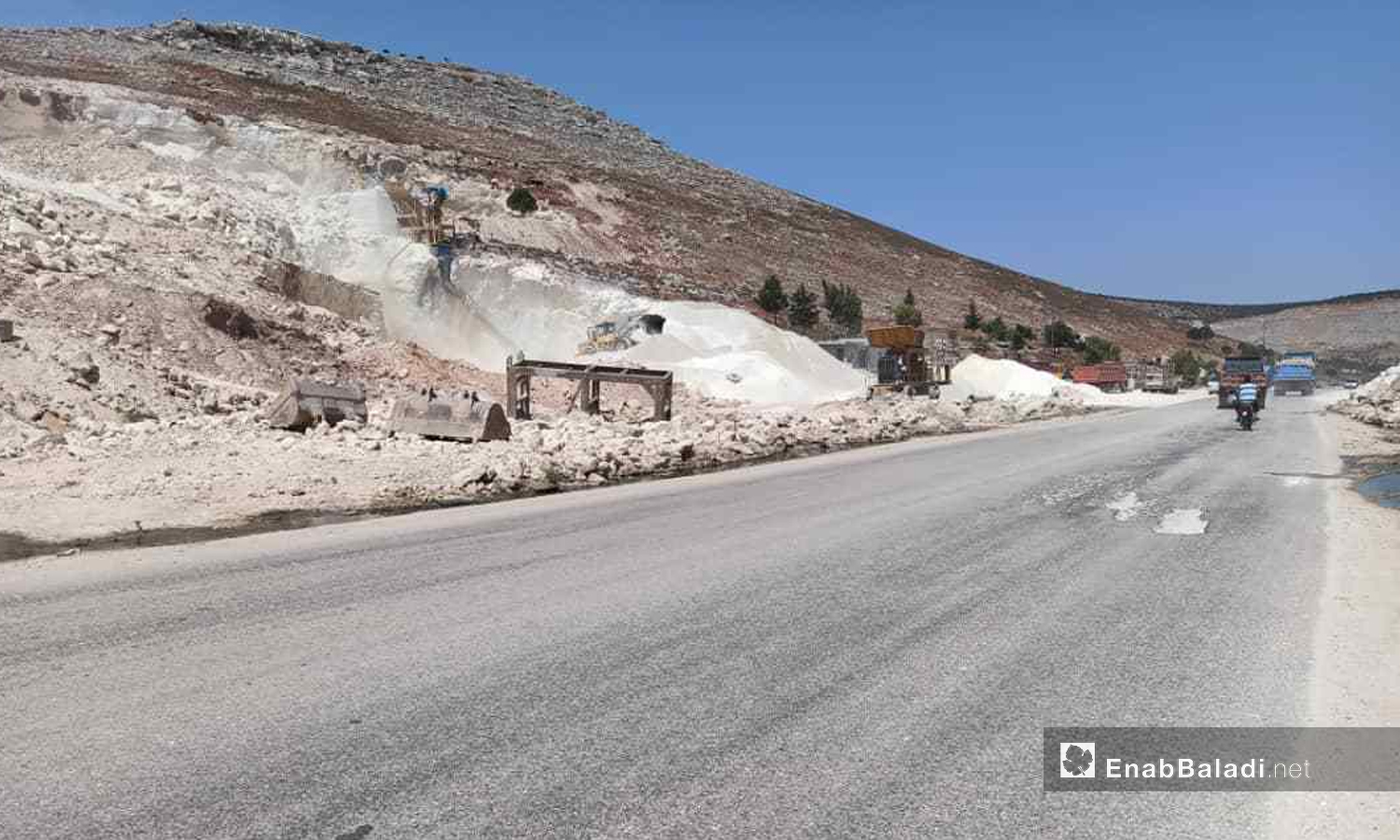



Idlib – Iyad Abdel Jawad
Several residents of “Deir Hassan” camps in the northern countryside of Idlib have complained about the presence of stone quarries near their camps, which poses serious health risks.
Stone quarries are spread widely in northwestern Syria’s mountain region.
The main purpose of quarries is to produce construction materials such as sand, gravel, and crushed stones and reuse rock debris in road construction. Quarrying is the process of extracting rock, sand, or other minerals from the ground to use them to produce materials for construction or other uses.
Abdel Moneim Ismail, one of the residents of the area, told Enab Baladi that following consecutive waves of displacement from the southern countryside of Idlib and south Aleppo, many internally displaced persons (IDPs) and residents of the “Deir Hassan” camps bought lands and set up their tents for sheltering themselves.
But after a while, sand quarries were opened in the Deir Hassan area, west of the displacement camps on both sides of the highway.
Last August, the number of quarries has gone up in the district. Consequently, people have begun to regularly suffer from the dust caused by the quarries in addition to other damages as a result of the dynamite explosions, which cause cracks in nearby homes, according to Ismail.
Ismail added that the “biggest problem” experienced by the camp residents is the air pollution resulted from the movement of heavy-duty quarrying vehicles on highways in conjunction with quarry blasts, noting that the roads turn into “a dust dump.”
Besides, quarries are closed to public roads, which creates a constant inconvenience to the locals. Quarry workers often block the road at every explosion, according to Ismail.
He pointed out that most of the quarries are located in the IDP camps’ vicinity, some of which are only 50 meters away.
Ismail said that new quarries have been made on Deir Hassan Road at the end of the highway, at the “black checkpoint.” This is exactly nearby stormwater sewers into which residents direct sewage lines, which turned the mouth of the drain into a pond filled with dirt and mosquitoes.
Abdul Qadir al-Hallaq, a resident of the “al-Huda” camp, linked to “Deir Hassan” camp, explained to Enab Baladi that the camps in the Deir Hassan region are numerous and large.
The most prominent gathering camps are “al-Wadhihi, al-Kuwaiti, Shashabo, al-Nahda, and Chimawi.” Moreover, many small camps are linked to the complex of camps, which means that the area is overcrowded.
Al-Hallaq said that the quarries are located in the center of these camps on the western side and are completely adjacent to the tents.
One of the quarries is about 300 meters away from Chimawi Camp. Another quarry is 500 meters from al-Nahda Camp, which is also located directly on Deir Hassan-Qah highway, on the side of which there is a valley through which dust passes and spreads to all the camps.
Al-Hallaq highlighted that many camp residents suffer from shortness of breath due to asthma or heart or respiratory problems, and it is difficult for them to cope with the rock dust caused by quarries.
Dust and dirt cover the tents and homes of the displaced. Furthermore, the thick dust clouds are formed when the air is still, then floating high in the air above the area, limiting visibility.
Deir Hassan is regarded as a quarry area, and it was not originally a residential area, according to Anas Raadoun, the owner of a quarry in Deir Hassan. The IDP camps were established next to the quarries and spread randomly around them following the recent wave of displacement, due to the progress of the Syrian regime forces on the fronts of the western countryside of Aleppo and southern Idlib, Raadoun told Enab Baladi.
Raadoun added that when he obtained a license to operate a quarry two and a half years ago, there were no homes or tents in the area; there were only quarries. He indicated that there are controls and laws for licensing quarries. For example, quarries must be away from residential places, stressing that the area in which quarries are spread is “the most appropriate option” for work.
Raadoun was wondering, “Where would the quarries be if people want to change their location?, noting that the quarries of Deir Hassan have been there since the area was under the control of the Syrian regime.
The so-called Salvation Government (SG), operating in Idlib governorate, granted licenses to quarry owners in the quarry area and not in the center of a city or town, according to Raadoun.
He confirmed that when his quarry, which is one of the oldest quarries in the region, was licensed, the nearest camp was at least one kilometer away from it.
He pointed out that the SG’s economic office said during a meeting with the quarries ‘owners that the government has a long-term plan to accommodate those affected by the quarries’ work in ready-made camps far from the quarry sites.
if you think the article contain wrong information or you have additional details Send Correction